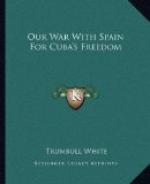The tobacco industry.
Cuban tobacco is famous throughout the world, and is one of the most profitable of all its products. Prior to 1791 the crop was sent to the national factories in Spain, by the “Commercial Company of Havana,” under government contract, but during that year the “Factoria de Tobacco” was established in Havana by the government. The tobacco was classified as superior, medium and inferior, and was received from the growers at fixed prices. In 1804 these were six, five and two and a half dollars per arrobe (a Spanish unit of weight, subject to local variations, but averaging about twenty-seven pounds avoirdupois).
By comparing the different prices with the quantity of each class of tobacco produced, we find that the “Factoria” paid an average price of $16 per hundred pounds for the leaf tobacco. With the expense of manufacture, the cigars cost the government seventy-five cents per pound; snuff, fine grain and good color, forty-three cents, and common soft, or Seville, nineteen cents a pound in Havana. In good years, when the crop amounted to 350,000 arrobes of leaf, 128,000 arrobes were manufactured for Spain, 80,000 for Havana, 9,200 for Peru, 6,000 for Buenos Ayres, 2,240 for Mexico, and 1,100 for Caracas and Campeachy.
In order to make up the amount of 315,000 arrobes, (for the crop loses ten per cent. of its weight, in loss and damage in the transportation and manufacture) we must suppose that 80,000 arrobes were consumed in the interior of the island; that is, in the country, where the royal monopoly did not extend. The maintenance of 120 slaves and the expenses of manufacture did not exceed $12,000 yearly; but the salaries of the officers of the “Factoria” amounted to $541,000. The value of the 128,000 arrobes of tobacco sent to Spain, in the abundant years, either in cigars, leaf or snuff, at the customary prices there, exceeded the sum of five million dollars.
It is surprising to see in the returns of the exports from Havana (documents published by the Consulado), that the exports for 1816 were only 3,400 arrobes; for the year 1823, only 13,900 arrobes of leaf tobacco; and in 1825 only 70,302 pounds of cigars and 167,100 pounds of leaf tobacco and strips; but we must remember that no branch of the contraband trade is more active than that in cigars. The tobacco of the Vuelta de Abajo is the most celebrated, but large quantities




